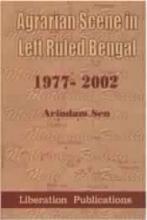Myth and Reality: Agrarian Scene in Left Ruled Bengal (1977 - 2002)
(This article, first published in Liberation Annual Nutnebr 2002, has been updated on the basis of two important documents released in May 2002 : (a) Document of the 20th State Conference of CPI(M) held in February 2002 and (b) Draft Agrarian Policy Document of the West Bengal Government.)
BOTH ADMIRERS and critics of the Left Front Government (LFG) concur that its spectacular success in holding on to power rests on its achievements on the agrarian front — on its solid rural base. On 21 June 2002, the LFG completed 25 years in office; would it not be in the fitness of things to use this occasion to make a fair assessment of its agrarian programme and to examine the emerging trends in political economy and class relations in the Left-ruled state which boasts the most stable government in India?
References:
Basu, Dipankar (2001): Political Economy of ‘Middleness’ Behind Violence in Rural Wast Bengal, EPW, April 21.
Bose, Biman (2000): Expose TC-BJP campaign of slander and violence – unleasb Mass struggles. People’s Democracy, September 24.
Bhaumik, Shankar Kumar (1994): Tenancy Relations and Agrarian Development – A study of West Bengal.
Ghatak, Maitreesh and Ghatak, Maitreya (2002): Recent Reforms in the Panchayati System in West Bengal toward Greater Participatory Governance? EPW January 5.
Ghosh, Ratan (1981): Agrarian Programme of the Left Front Government, EPW, June (Review of Agriculture).
Government of West Bengal (1995): The Recommendations of The. State Finance Commission, 1990-95.
Khasnabis, Ratan (1994): Tenurial Conditions in West Bengal : Continuity and Change, EPW, December 31.
Lenin, Vladimir Ilyich: The Agrarian Question in Russia Towards the Close of the Nineteenth Century, Collected Works, Moscow 1973, vol. 15. Marx, Karl: Capital, Vol. Ill, chapter 20.
Ray Ranjan (2000): Poverty, Household Size and Child Welfare in India, EPW, September 23.
Theisenhusen, William C. (2001): Poverty Amidst Plenty, in Horacio R Morales, Jr., James Putzel et al (eds): Power-In The Village.

